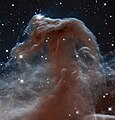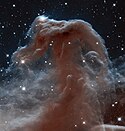Mgławica Koński Łeb
 Mgławica Koński Łeb (ESO) | |
| Odkrywca | |
|---|---|
| Data odkrycia | 1888 |
| Dane obserwacyjne (J2000) | |
| Gwiazdozbiór | |
| Typ | |
| Rektascensja | 05h 40m 59s |
| Deklinacja | −02° 27′ 30″ |
| Odległość | |
| Rozmiary kątowe | 8' × 6' |
| Charakterystyka fizyczna | |
| Wymiary | 3,5 ly |
| Alternatywne oznaczenia | |
| Barnard 33 | |
Mgławica Koński Łeb (znana także jako Barnard 33 wewnątrz IC 434) – ciemna mgławica znajdująca się w konstelacji Oriona. Odkryła ją w 1888 roku Williamina Fleming na płytach fotograficznych wykonanych w Harvard College Observatory[1].
Mgławica jest położona zaraz poniżej gwiazdy Alnitak, najbardziej wysuniętej na wschód gwiazdy Pasa Oriona i jest częścią znacznie większego Zespołu Obłoków Molekularnych Oriona. Leży w przybliżeniu 1500 lat świetlnych od Ziemi i ma średnicę około 3,5 roku świetlnego.
Czerwony blask pochodzi od gazu wodorowego położonego głównie za Mgławicą Koński Łeb, zjonizowanego przez pobliską gwiazdę sigma Orionis. Mgławicę tę rozjaśnia znajdująca się za nią mgławica emisyjna IC 434[2]. Ciemność mgławicy Koński Łeb jest spowodowana głównie przez gęstą warstwę pyłu, chociaż dolna część szyi Końskiego Łba rzuca cień na lewo. Strumienie gazu opuszczającego mgławicę są skierowywane przez silne pole magnetyczne. Jasne punkty przy podstawie mgławicy Koński Łeb to młode gwiazdy w procesie formowania.
Galeria
Zobacz też
Przypisy
- ↑ S. R. Waldee, M. L. Hazen. The discovery of early photographs of the Horsehead nebula. „Publications of the Astronomical Society of the Pacific”. 102, s. 1337, listopad 1990. DOI: 10.1086/132771. Bibcode: 1990PASP..102.1337W (ang.).
- ↑ Mgławica Koński Łeb w serwisie APOD: Astronomiczne zdjęcie dnia
Bibliografia
- Mgławica Koński Łeb w bazie SIMBAD (ang.)
- Mgławica Koński Łeb w serwisie APOD: Astronomiczne zdjęcie dnia
Media użyte na tej stronie
Autor: European Southern Observatory, Licencja: CC BY 4.0
A reproduction of a composite colour image of the Horsehead Nebula and its immediate surroundings. It is based on three exposures in the visual part of the spectrum with the FORS2 multi-mode instrument at the 8.2-m KUEYEN telescope at Paranal. It was produced from three images, obtained on February 1, 2000, with the FORS2 multi-mode instrument at the 8.2-m KUEYEN Unit Telescope and extracted from the VLT Science Archive Facility . The frames were obtained in the B-band (600 sec exposure; wavelength 429 nm; FWHM 88 nm; here rendered as blue), V-band (300 sec; 554 nm; 112 nm; green) and R-band (120 sec; 655 nm; 165 nm; red). The original pixel size is 0.2 arcsec. The photo shows the full field recorded in all three colours, approximately 6.5 x 6.7 arcmin 2 . The seeing was about 0.75 arcsec. This image is available as a mounted image in the ESOshop. #L
Autor: Hewholooks, Licencja: CC BY-SA 3.0
Region of the Horsehead Nebula south of star Alnitak in Orion.
(c) ESA/Hubble, CC BY 4.0
Astronomers have used NASA's Hubble Space Telescope to photograph the iconic Horsehead Nebula in a new, infrared light to mark the 23rd anniversary of the famous observatory's launch aboard the space shuttle Discovery on April 24, 1990.
Looking like an apparition rising from whitecaps of interstellar foam, the iconic Horsehead Nebula has graced astronomy books ever since its discovery more than a century ago. The nebula is a favorite target for amateur and professional astronomers. It is shadowy in optical light. It appears transparent and ethereal when seen at infrared wavelengths. The rich tapestry of the Horsehead Nebula pops out against the backdrop of Milky Way stars and distant galaxies that easily are visible in infrared light.
Hubble has been producing ground-breaking science for two decades. During that time, it has benefited from a slew of upgrades from space shuttle missions, including the 2009 addition of a new imaging workhorse, the high-resolution Wide Field Camera 3 that took the new portrait of the Horsehead.



